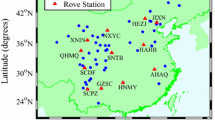Abstract
Interferometric calibration always yields non unique solutions. It is therefore essential to remove these ambiguities before the solutions could be used in any further modeling of the sky, the instrument or propagation effects such as the ionosphere. We present a method for LOFAR calibration which does not yield a unitary ambiguity, especially under ionospheric distortions. We also present exact ambiguities we get in our solutions, in closed form. Casting this as an optimization problem, we also present conditions for this approach to work. The proposed method enables us to use the solutions obtained via calibration for further modeling of instrumental and propagation effects. We provide extensive simulation results on the performance of our method. Moreover, we also give cases where due to degeneracy, this method fails to perform as expected and in such cases, we suggest exploiting diversity in time, space and frequency.






Similar content being viewed by others
References
Boyd, S., Vendenberghe, L.: Convex Optimization. Cambridge University Press, Cambridge (2004)
Chen, B., Petropulu, A.P.: Frequency domain blind MIMO system identification based on second- and higher order statistics. IEEE Trans. Signal Process. 49(1), 1677–1688 (2001)
Cotton, W.D.: Polarimetry. In: Zensus, J.A., Diamond, P.J., Napier, P.J. (eds.) ASP Conference Series, Very Long Baseline Interferometry and the VLBA, vol. 82, pp. 289–308 (1995)
Hamaker, J.P.: Understanding radio polarimetry IV: the full-coherency analogue of scalar selfcalibration. Astron. Astrophys. Suppl. 143(3), 515–534 (2000)
Hamaker, J.P., Bregman, J.D., Sault, R.J.: Understanding radio polarimetry, paper I. Astron. Astrophys. Suppl. 117(137), 96–109 (1996)
Higham, N.J.: Functions of Matrices: Theory and Computation. SIAM, Philadelphia (2008)
Intema, H.T., van der Tol, S., Cotton, W.D., Cohen, A.S., van Bemmel, I.M., Rottgering, H.J.A.: Ionospheric calibration of low frequency radio interferometric observations using the peeling scheme. I. Method description and first results. Astron. Astrophys. 501(3), 1185–1205 (2009)
Lourakis, M.I.A.: Levmar: Levenberg–Marquardt nonlinear least squares algorithms in C/C+ +. http://www.ics.forth.gr/~lourakis/levmar/ (2004)
van der Tol, S., van der Veen, A.J.: Ionospheric calibration for the LOFAR radio telescope. In: IEEE International Symposium on Signals, Circuits and Systems, 2007 ISSCS 2007, pp. 1–4 (2007)
Yatawatta, S., Petropulu, A.P., Dattani, R.: Blind channel estimation using fractional sampling. IEEE Trans. Veh. Technol. 53(2), 363–371 (2004)
Acknowledgements
We thank Ger de Bruyn and Wim Brouw for initial comments and suggestions. We also thank the anonymous reviewers for the careful review and helpful comments that enabled us to enhance this paper.
Author information
Authors and Affiliations
Corresponding author
Rights and permissions
About this article
Cite this article
Yatawatta, S. Reduced ambiguity calibration for LOFAR. Exp Astron 34, 89–103 (2012). https://doi.org/10.1007/s10686-012-9300-7
Received:
Accepted:
Published:
Issue Date:
DOI: https://doi.org/10.1007/s10686-012-9300-7




